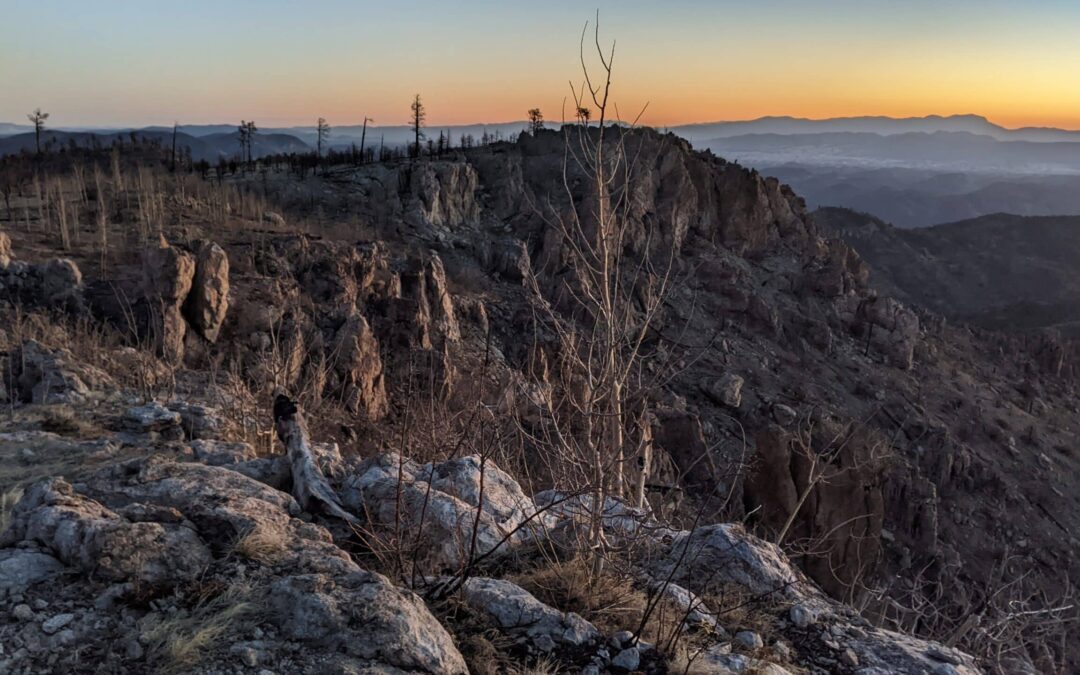Gila National Forest teams up with various partners to restore a burned landscape
SILVER CITY, NM – The Gila National Forest is on the long road to recovery of a landscape burned during the Black Fire, which blackened 325,136 acres of state, private, and Gila National Forest lands in 2022. The vast majority of the fire perimeter burned at low to moderate intensity, with less than 10% that burned at high intensity. Where low to moderate intensity fire occurred, recovery of surface vegetation is expected to occur naturally.]
More about CDTC’s efforts in the Black Range in the Autumn issue of Passages!
A variety of partners have come to the table to help increase the pace and scale of restoration work that can be accomplished over the next few years, especially on those lands not expected to be restored on their own. On August 8, the forest teamed up with Bat Conservation International to aerially seed 7,617 acres on steep slopes that burned at high severity, to accelerate the recovery of surface vegetation and help hold soil in place during rain events. A monitoring trip on September 11 found abundant green vegetation growing in beneath the burned trees. Photos of the recovery in progress can be viewed at Gila National Forest – New Mexico | Flickr.

“Considering the modest monsoons we experienced this year, we were pleasantly surprised with the amount of surface vegetation, both from seeded species and natural recovery,” said Burned Area Emergency Response Coordinator for the Black Fire, Mike Natharius. “It’s good to see some protective ground cover in these watersheds, as erosion observed during last year’s post-fire monsoons was extreme.”
In addition to the beginning of vegetative recovery, the forest and partners are working to rebuild or repair range fencing that was damaged or destroyed during the fire. The forest has purchased 60 miles worth of wire, posts, and stays to repair fences. The Sierra Soil and Water Conservation District has stepped up to assist with packing in and/or reconstructing three fences north of the Aldo Leopold Wilderness, while one of the forest’s grazing permittees will replace some of their lost fencing.
Other grazing permittees opted to try out virtual fencing with 300 cow collars and equipment distributed through partnership with New Mexico State University. The virtual fence system relies on technology to create virtual boundaries along with GPS-enabled shock collars that control cattle movement and grazing. Initially, there was a small group of cattle that persistently pushed through shock zones to access a riparian area. Additional shock zones were added, which stopped the riparian incursions. So far, the program has been 90% effective in keeping cattle where they belong with less reliance on physical fences, which is less costly for construction and maintenance and better for wildlife.
Progress is also being made on repairs and improvements to trails and other recreational facilities. On September 15, the forest entered into a partnership with the National Forest Foundation to restore damaged recreational trails and livestock fences affected by the Black Fire. Specific tasks associated with this agreement include improvements and repairs from fire impacts to the trail system, trailheads, vistas, and other infrastructure such as water tanks, fences, and corrals. The National Forest Foundation will be hiring a Project Coordinator to assist with managing improvements with the Forest Service and other key partners such as Natural Curiosity, Continental Divide Trail Coalition, and the Gila Chapter of the Back County Horsemen. Throughout the summer trail assessments were completed in the Aldo Leopold Wilderness to determine the amount of work needed to restore the trail system. The assessment concluded we have approximately 50 miles of low complexity trail work, approximately 100 miles of medium complexity trail work and approximately 15 miles of high complexity trail work needed that may require new trail construction, corridor clearing, tread excavation, retaining wall construction and additional drainage installations.
These efforts are ongoing and recovery of the Black Fire area will continue to be one of the Gila National Forest’s major concerns over the next few years. The 2022 Black Fire ignited on a dry, windy day in May 2022. When it was done, it was the State of New Mexico’s second largest wildfire on record, burning over more than 90% of the Aldo Leopold Wilderness Area, and damaging or destroying many miles of range fence and other infrastructure.

